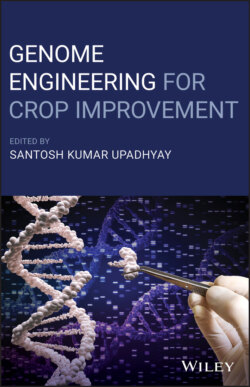Читать книгу Genome Engineering for Crop Improvement - Группа авторов - Страница 54
3.4.1.7 Application of CRISPR/Cas9 for Cotton Quality Improvement
ОглавлениеCotton fiber quality is directly related to boost the economy determining the income of almost 100 million families from more than 100 countries (Guan et al. 2014). Tetraploid cotton retains special features such as larger fiber length and fiber strength to facilitate more spinnable cotton. Cotton fibers contain single‐celled trichomes originating from outer integument cells of the ovular surface. Fiber developmental mechanisms comprising four levels, fiber‐cell initiation, elongation, secondary cell wall biosynthesis and maturation (Manik and Ravikesavan 2009). The overlapping developmental stages have some special features differentiating cellular and physiology. This is due to complexity of cotton fiber transcriptome involving ~18 000 and 36 000 genes in diploid and allotetraploid cotton genomes, respectively (Arpat et al. 2004). Several key fiber‐related genes have been identified creating interest to study their functions and subsequent improvement of enhance fiber quality. Some key genes including E6 (John and Crow 1992), GhExp1 (Harmer et al. 2002), GhSusA1 (Jiang et al. 2012), PIP2s (Li et al. 2013) and GA20ox (Bai et al. 2014) were reported predominantly expressed during fiber initiation, secondary cell wall biosynthesis (Brill et al. 2011), and fiber elongation (Yang et al. 2014). Taking an example, protodermal factor1 gene (GbPDF1) specifically regulates fiber initiation by the HDZIP2‐ATATHB2 core cis element (Deng et al. 2012). Similarly, alpha‐expansins (GhExp1) overexpression regulate fiber elongation encoding cell wall loosening proteins (Harmer et al. 2002). In addition, several related genes are highly expressed during fiber elongation. Earlier, antisense suppression of sucrose synthase (SuSy) was revealed to suppress fiber elongation due to change in osmosis (Ruan et al.2007). In contrast, proline‐rich protein‐coding (GhPRP5) was found as a negative regulator of fiber development (Xu et al. 2013).
Cellulose synthesis is a principal event in fiber cells during the secondary cell wall biosynthesis. Previously, many efforts have been made to explore how the cotton fiber regulates and supports the strong irreversible carbon sink characterized by secondary wall cellulose synthesis (Brill et al. 2011). It has been shown that suppression of Sus gene expression affects the cellulose deposition (Brill et al. 2011), emphasizing the importance of this enzyme in cellulose synthesis. Subsequently, Brill et al. (Brill et al. 2011) identified and characterized a novel Sus isoform (SusC), which was up‐regulated during secondary wall cellulose synthesis in cotton fiber. Besides secondary wall cellulose synthesis, the maturation stage of fiber development begins. During fiber maturation, the majority of the expressed genes belong to cellular respiration (Kim et al. 2013). Many genes encoding transcription factors, that are MYB, C2H2, bHLH, WRKY, and HD‐ZIP families, were also expressed during cotton fiber development. Previously, various studies indicated that MYB‐related genes have high expression during fiber development in G. hirsutum (Machado et al. 2009). For example, expression studies of six MYB‐related genes in G. hirsutum indicated that GhMYB6 has high expression in cotton fiber (Loguercio et al. 1999), while R2R3 MYB‐like transcription factor‐encoding gene “GhMYB109” is particularly expressed in fiber initiation and elongation (Suo et al. 2003). The RAD‐like GbRL1 was also highly expressed in cotton ovules during fiber initiation (Zhang et al. 2011). TCP transcription factor has played a significant role in fiber and root hair development by controlling the jasmonic acid biosynthesis, ethylene signaling, calcium channel and reactive oxygen species (Hao et al. 2012). Though, GhHOX3 from class IV homeo‐domain‐leucine zipper (HD‐ZIP) family showed strong expression during early fiber elongation (Shan et al. 2014). Besides transcription factors, phytohormones such as ethylene, auxins and brassinosteroids (BR) also play a critical role during fiber development. Ethylene plays a vital function in fiber elongation by stimulating the pectin biosynthesis network (Qin and Zhu 2011), while gibberellins (GA) and indole‐3‐acetic acid (IAA) are required for fiber initiation and elongation in cotton (Xiao et al. 2010). In contrast, the persistent high concentration of jasmonic acid (JA) inhibits fiber elongation (Tan et al. 2012). Though several gene expression studies have been reported on cotton fiber development, some issues are illustrated here. First, most of the differentially expressed genes identified by the comparative analyses are associated with variations between species rather than related to fiber traits. Second, in some cases, the use of the protein‐coding gene sequences from Gossypium raimondii and Gossypium arboreum may not be accurate enough for gene annotation in tetraploid cotton. Third, it is unknown whether any of the expressed genes recognized from earlier reports had sequence variations between a cotton fiber mutant and its wild type because only the differentially expressed genes having sequence differences and co‐localization with target fiber traits are possible candidates for advanced cotton studies. These excellent contributions extremely facilitate vector construction for functional genes analyses and screening via the “genotype‐to‐phenotype” approach. Thus, the arsenal of cotton genomic manipulation urgently needs to be updated to meet the demand for rapid and precise dissecting gene functional analyses. Based on the presented facts and the well‐documented functional genomics of fiber quality traits, along with the availability of genetic resources and the high transformation efficiency, the employment of the CRISPR/Cas system is a better choice for cotton fiber quality improvement.
